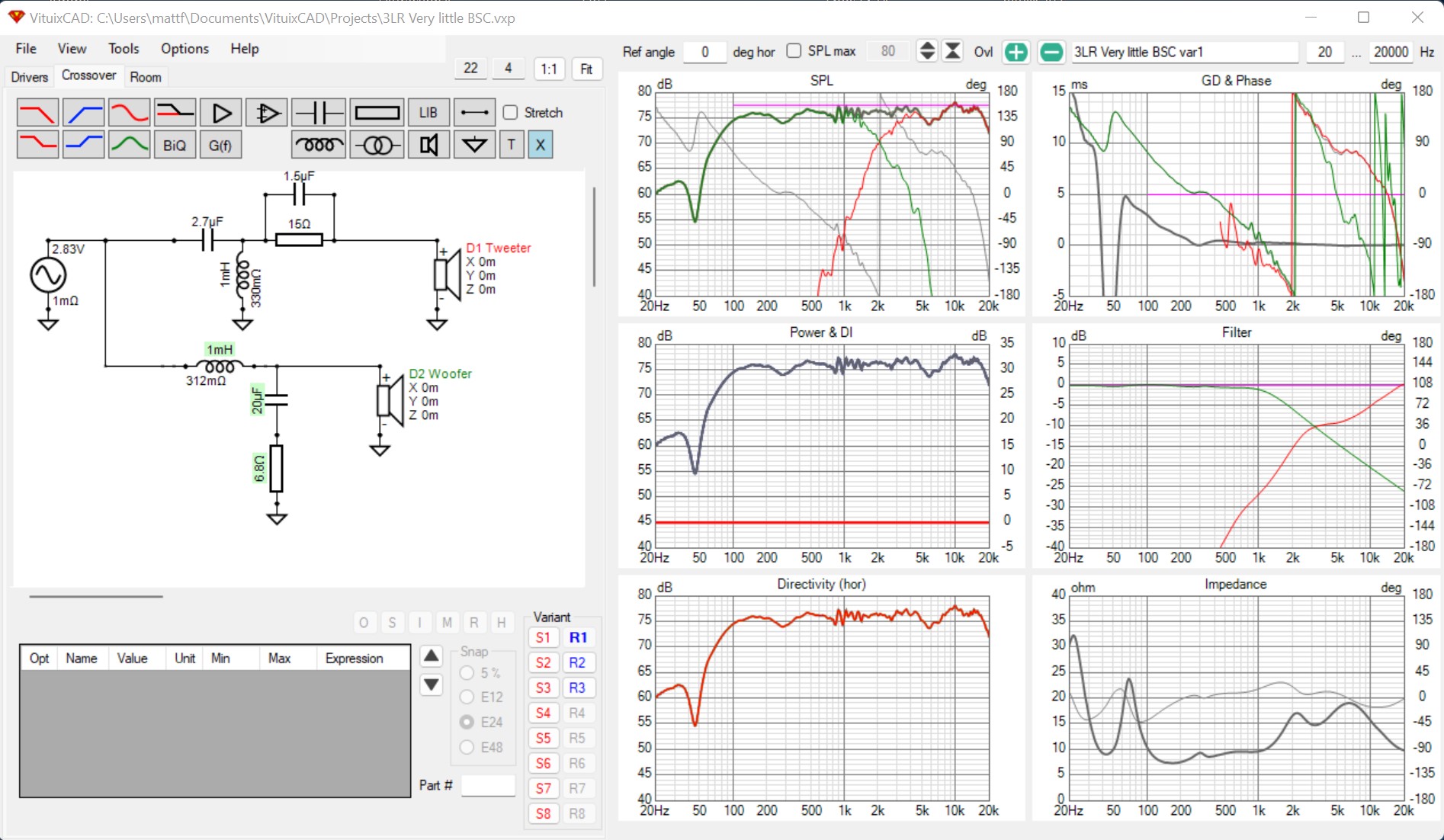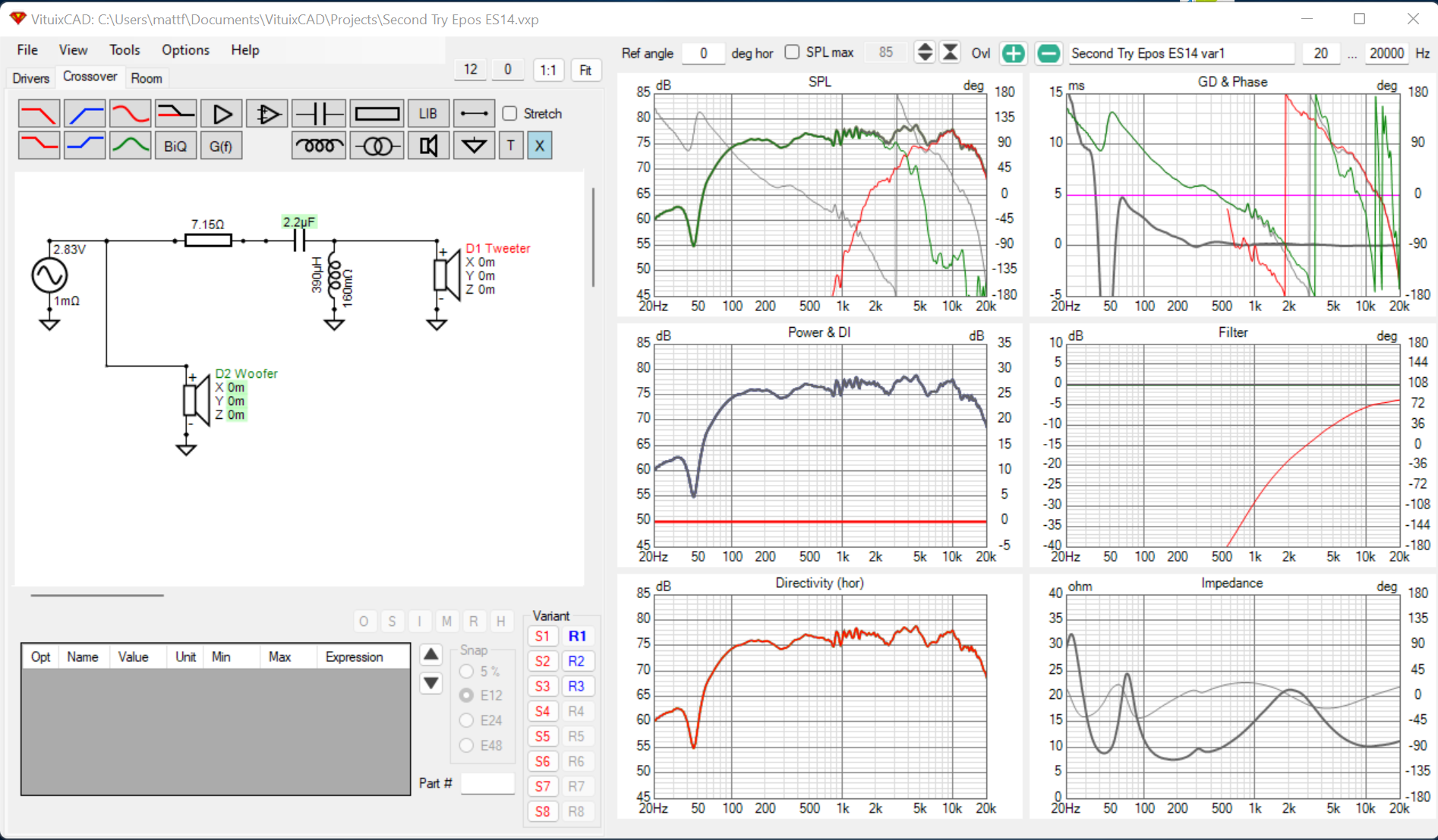You are using an out of date browser. It may not display this or other websites correctly.
You should upgrade or use an alternative browser.
You should upgrade or use an alternative browser.
I am the (ES14) tweaker!
- Thread starter The Captain
- Start date
david ellwood
Kirabosi Kognoscente
Did you play with speaker position after changing the crossovers?
The Captain
~~~~~~~~~~
Did you play with speaker position after changing the crossovers?
Hi David, no I just can't do this. It's primarily a sittingroom so the speakers can't be pulled out say 2ft into " ideal" position as they'd drive me potty (& get in the way of the tv).
I like them where they are & tbh seem to work fine too.
Fatmarley
"It appears my intelligence circuits have melted"
OK, here's one with very little BSC (no extra bass/lower mids), good phase tracking and the frequency response isn't bad. It's 4LR (as can be seen by the phase graph), but using 3LR slopes. It basically has a relaxed 'knee' compared to a traditional LR4 filter.


The Captain
~~~~~~~~~~
Hiya FatM, hope you've revovered.
Very grateful for this new idea. Can you remind me what the pink line represents? Or is it an arbitrary line you've added perhaps ( but still the reasoning behind it isn't clear to me if so).
What is the significance of having the two sharp/ steep lines on the phase graph, being closer together? I mean I know the answer is likely "better phase"... but this don't actually mean anything to me yet. I sense it has something to do with the drivers "working together" better, but even this doesn't result in me understanding the significance.
As you can see I'm still hopelessly unable to understand the content of each individual graph! The shape of one (& best-guessing what this results into, audibly) is still as much as I can "read" so far.
Maybe someone can give FatM a break from my ineptitude, & jump in with a bit of help? Grateful if so.
Thanks a bunch
Very grateful for this new idea. Can you remind me what the pink line represents? Or is it an arbitrary line you've added perhaps ( but still the reasoning behind it isn't clear to me if so).
What is the significance of having the two sharp/ steep lines on the phase graph, being closer together? I mean I know the answer is likely "better phase"... but this don't actually mean anything to me yet. I sense it has something to do with the drivers "working together" better, but even this doesn't result in me understanding the significance.
As you can see I'm still hopelessly unable to understand the content of each individual graph! The shape of one (& best-guessing what this results into, audibly) is still as much as I can "read" so far.
Maybe someone can give FatM a break from my ineptitude, & jump in with a bit of help? Grateful if so.
Thanks a bunch
Fatmarley
"It appears my intelligence circuits have melted"
Hiya FatM, hope you've revovered.
Feeling a bit better today. Did a test, and it's negative, but I still have a bit of a cough.
Very grateful for this new idea. Can you remind me what the pink line represents? Or is it an arbitrary line you've added perhaps ( but still the reasoning behind it isn't clear to me if so).
Ignore it. I just put it there to help line up the frequency response.
What is the significance of having the two sharp/ steep lines on the phase graph, being closer together? I mean I know the answer is likely "better phase"... but this don't actually mean anything to me yet. I sense it has something to do with the drivers "working together" better, but even this doesn't result in me understanding the significance.
When you consider the fact that the phase is 90 degrees apart with a 3rd order BW crossover, it tells you that phase doesn't have to track perfectly. It just helps give you a predictable frequency response, on and off-axis.
As you can see I'm still hopelessly unable to understand the content of each individual graph! The shape of one (& best-guessing what this results into, audibly) is still as much as I can "read" so far.
Most of the graphs aren't applicable because I didn't take off-axis measurements. That's my next project - getting set up for off-axis measurements to (hopefully) take advantage of the full power of VituixCAD.
With your speaker being tight in the corner of the room, the last graph I did (post #24) is the circuit to try, because it has the least amount of bass. Although the port produces most of the bass below 100hz, you'll still get reinforcement at 100hz with corner placement, so a flat response may not work in your room (even with the ports plugged).
Maybe someone can give FatM a break from my ineptitude, & jump in with a bit of help? Grateful if so.
Thanks a bunch
It would be great if someone could jump in and offer any advice. I know a bit, but I'm no expert.
Once I've mastered VituixCAD, and have my off-axis measurement set-up perfected. I can always measure your speakers again sometime in the future, and have another go...
The Captain
~~~~~~~~~~
@Fatmarley glad you're back on track & not the dreaded lurgi..
At the mo FatM I'm actually loathed to change the current set up, although would be intriguing to knock up this new crossover idea. Just really enjoying them as is. No doubt the itch will need to be scratched.. but until funds get better I will stay as is. Xmas time I think I'll either do your latest one if- I have a few more beans, or do the previous one.
In meantime I'll dive in & try understanding some more, so better placed to know why I'm actually building the crossover as of when.
If anyone else wants to try a new es14 tweeter, or es11, I have unused birch ply sections foc for you to make a tweeter baffle/ pm me.
Thanks, capt
At the mo FatM I'm actually loathed to change the current set up, although would be intriguing to knock up this new crossover idea. Just really enjoying them as is. No doubt the itch will need to be scratched.. but until funds get better I will stay as is. Xmas time I think I'll either do your latest one if- I have a few more beans, or do the previous one.
In meantime I'll dive in & try understanding some more, so better placed to know why I'm actually building the crossover as of when.
If anyone else wants to try a new es14 tweeter, or es11, I have unused birch ply sections foc for you to make a tweeter baffle/ pm me.
Thanks, capt
Fatmarley
"It appears my intelligence circuits have melted"
You are probably right not to rush into things. With a typical set of speakers, I can easily model up to 100 or more crossovers, but that does involve listening to quite a few iterations in-between. Once you've listened, it helps you decide what to do next, so I'm working blind here.
I'll keep trying, and if I think I've come up with something better, I'll let you know.
Ideally, I'd have a pair here to play with, but they aren't cheap. At least they weren't when I last looked on ebay.
I'll keep trying, and if I think I've come up with something better, I'll let you know.
Ideally, I'd have a pair here to play with, but they aren't cheap. At least they weren't when I last looked on ebay.
The Captain
~~~~~~~~~~
100 crossovers?! My goodness I had thought you might go for 'a few' tries only, before landing on one. No wonder those diy speakers of yours sound so good then, as good as big 3-way JBL's I heard in mid 80's I thought.
Btw did the bits get back to you ok?
Btw did the bits get back to you ok?
Fatmarley
"It appears my intelligence circuits have melted"
100 crossovers?! My goodness I had thought you might go for 'a few' tries only, before landing on one. No wonder those diy speakers of yours sound so good then, as good as big 3-way JBL's I heard in mid 80's I thought.
Btw did the bits get back to you ok?
Cheers - A lot of it is trying to get the baffle step correction right. It's one of those things that needs to be adjusted to suit your room / speaker placement, so has to be done by ear. A 3-way compared to a 2-way, takes a bit more adjusting too, but does mean you have more control over the final frequency response. Looking forward to measuring them properly for VituixCAD - hopefully I can squeeze a bit more performance out of them. Not that I can detect any faults.
Yes, I've got the bits back - Thanks


